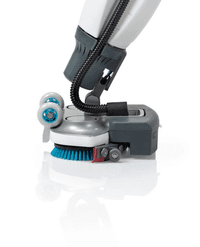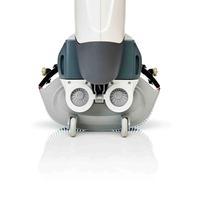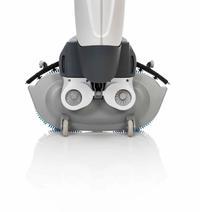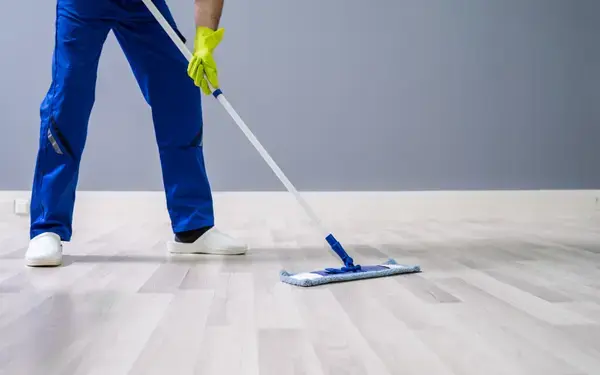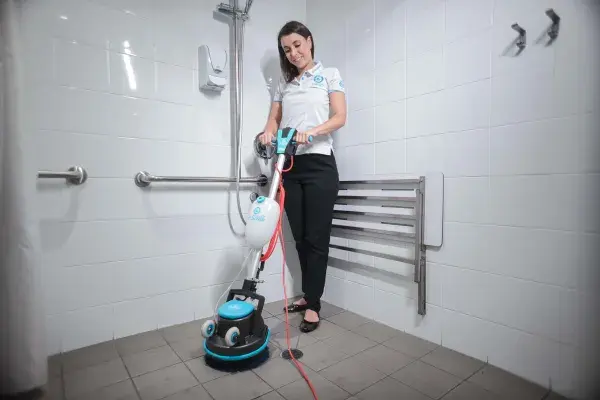You are reading: What’s the Best Floor Scrubber for a Commercial Kitchen?
07 March 2023
7min read time
Brooke Payne
What’s the Best Floor Scrubber for a Commercial Kitchen?
Share:

Key Insights
- Cylindrical scrubbers provide great cleaning results in small to medium spaces, allowing you to clean within grout lines.
- Disc scrubbers provide some of the best cleaning results, due to their powerful motors that can agitate and lift stains with a single pass-over.
- Walk-behind disc scrubbers are the most powerful cleaning tool for a commercial kitchen, offering superior pressure and agitation that lifts tough stains.
A commercial kitchen floor can be one of the hardest floors to clean. That’s because of the fatty oil-based grime which can find its way into crevices, grout lines and other hard to clean places. They also harbour bacteria and germs that can cause lingering smells and because of this, a standard spaghetti mop just won't cut it. In order to thoroughly clean and disinfect floors to a commercial kitchen standard, you'll want to consider using a floor scrubber.
While many floor scrubbers have similar features it's important to understand the different types available so you can make the right decision when purchasing one for your commercial kitchen.

What are the Floor Scrubber Options for Cleaning a Commercial Kitchen?
There are 3 different of categories of scrubbers to choose from, each available in a range of sizes. These options include:
- Cylindrical Scrubbers
- Flexible Upright Disc Scrubbers
- Walk-behind Disc Scrubbers
Cylindrical scrubbers
A cost-effective option when it comes to cleaning floors in a kitchen are cylindrical scrubbers, but they do have limitations. Cylindrical scrubbers provide great cleaning results in small to medium spaces, allowing you to clean within grout lines. They feature debris trays that can pick up food waste on the ground, but this can fill up quickly in a large commercial kitchen.
Cylindrical scrubbers can spin up to 1050 RPM and often only have a single roller brush. Water is spread via a drip tray that sits in front of the brushes. The motion of the brush throws loose dirt and particles into a tray that's emptied by the operator after cleaning is completed. This eliminates the need for pre-sweeping before scrubbing.
However cylindrical scrubbers are limited when it comes to cleaning tight, difficult-to-reach areas. They do not clean edges well, and can also leave behind significant amounts of water, adding to slip hazards.
It is also important to note that cylindrical vacuums are available as both a walk behind machine, as well as a no vacuum system.
Pros
- Good for very rough floors
- Excellent cleaning power
- Good value for entry level operators/small restaurants
- Available in sizes from 24 – 75cm scrubbing widths
Cons
No vacuum systems can be slower as the user will need to go over the same area several times to lift water
Small units are not really designed for daily cleaning – more a periodic deep clean
Smaller units with no vacuum system tend to leave floor wet; increased slip/fall risks
Flexible upright disc scrubbers
Disc scrubbers provide some of the best cleaning results, due to their powerful motors that can agitate and lift stains with a single pass-over. This is particularly useful in commercial kitchens where you'll find tough, dried-out stains that are difficult to remove. Because of the downward pressure used to operate a disc machine, very heavily soiled floors can be addressed.
Some of the leading disc scrubbers on the market feature an inbuilt vacuum system that lifts the dirty water from the surfaces as you pass over it, adding to the hygiene of your kitchen space. Using a disc scrubber also allows you to alternate the pad or brush that you’re using, specifically for your kitchen’s floor surface, and the stains that you’re cleaning.
Pros
Incredibly maneuverable; can clean virtually anywhere a mop can
Great for cleaning around obstacles in the kitchen
Choice of brushes or pads to suit different floors: ie hard brushes for back of house nonslip floors, lighter brushes or pads for polishing glossy floors
Best combination of speed, agility and performance
Suitable for everyday cleaning – will maintain a floor at top level so doesn’t really need a deep clean
Lightweight & compact – good for areas with limited storage space, or for use on multiple floor levels
Cons
Not as good on very rough nonslip floors as a cylindrical scrubber
On rough non-slip floors, you'll be likely to use more non consumable items such as brushes, pads and squeegees
Smaller tank capacity increases refill/emptying frequency
Walk-behind Disc Scrubbers
Walk-behind disc scrubbers are the most powerful cleaning tool for a commercial kitchen, offering superior pressure and agitation that lifts tough stains. Walk behind disk scrubbers are ideal for commercial applications as they remove almost all scuff marks and grime and can increase floor shine over time with continued use. The disk brushes offer greater down pressure than cylindrical brooms which means they can clean heavily soiled floors with ease.
Walk behind scrubbers also suction any dirty water off the floors leaving them dry almost instantly, which is a huge benefit and can help prevent any slips or falls.
Some units can be quite bulky though and may not be appropriate for the size of your kitchen.
Pros
- Good for large open areas
- High-power motors provide great agitation of tough stains and class-leading cleaning power
- Large tank capacities give extended runtime
- Suitable for everyday cleaning – will maintain a floor at top level, so doesn’t really need a deep clean
- Built-in vacuum lifts moisture as it cleans
- Choice of brushes or pads (same as flexible upright scrubbers)
Cons
- Large footprint requires a larger storage area
- Bulky design is not as maneuverable as a flexible upright scrubber; not ideal for cleaning around trollies, tables, in bathrooms etc.
- Comparatively heavy, not suitable for multiple floor levels unless you have a lift
Read the best pads and brushes for your floor scrubber on 7 different floor surfaces.
What’s the Best Floor Scrubber for a Commercial Kitchen?
This depends on a range of factors, but some key ones would be your budget, how large the floor area is, and what features your commercial kitchen requires from a floor scrubber.
If you’re looking for one piece of cleaning equipment that can meet all your needs in a commercial kitchen, we believe that a disc scrubber with an inbuilt vacuum system is the best tool for the job. If you’re on a tight budget, a cylindrical scrubber is still a great and cost-effective cleaning tool, however, they offer slower operation speeds and cleaning power compared to a traditional scrubber.
Discover more tips in this article: How to choose a floor scrubber?

4 Tips for Cleaning Your Commercial Kitchen with a Floor Scrubber
1) We recommend that you sweep or vacuum the floor before using your floor scrubber, to provide the best cleaning results while reducing any chances of blockages from food debris on the floor.
2) In terms of your chemical mix, opt for a mild alkaline cleaning solution. Using a basic or alkaline cleaning solution helps to break down the proteins, fats and oils that you’ll find all over a commercial kitchen, making it far easier to lift from the surface.
3) Avoid overly strong chemical mixes that can leave visible residue on your floor and can damage the mechanical parts of the floor scrubber itself.
4) If you’re using a large automatic floor scrubber, try to cut in from the edges with the help of a compact floor scrubber like the i-mop lite; ignoring these edges can lead to an accumulation of bacteria and bad smells.
To find out more about our revolutionary i-mop floor scrubber range, click here.
Common Questions Answered
1. What are the key specifications to consider when choosing a floor scrubber for a commercial kitchen?
Answer: When selecting a floor scrubber for a commercial kitchen, consider specifications such as tank capacity, scrubbing width, battery life, and maneuverability. Additionally, look for models with a high RPM (revolutions per minute) to effectively remove stubborn grease and grime.
2. How do you maintain a floor scrubber used in a commercial kitchen?
Answer: Regular maintenance includes daily cleaning of the squeegee and brushes, checking and replacing worn parts, and ensuring the water and solution tanks are emptied and cleaned to prevent odors and bacterial growth.
3. Can a floor scrubber handle grease and oil spills typically found in commercial kitchens?
Answer: Yes, many commercial floor scrubbers are designed to handle grease and oil spills. Look for units equipped with specialized pads and brushes that are effective against oily residues, and ensure the cleaning solution used is formulated to cut through grease.
References
Tennant Co – Floor Scrubber Guide for Commercial Kitchens
URL: https://www.tennantco.com/commercial-kitchen-scrubber-guide
CleanLink – Selecting the Right Floor Scrubber for Foodservice
URL: https://www.cleanlink.com/floor-scrubber-foodservice
i-team ANZ
URL: https://www.i-teamanz.com
Products Featured Inside this Article
Media and Insights
Join the movement that's changing what clean means.
Be part of a cleaner world. Get a live demo at a time that suits you.
Book a Demo